|
twin engine set-up
|
| rusty geller |
Posted on 01/13/09 - 7:34 PM
|
Member
Personal Page
Posts: 13
Comments:
0
Joined: 11/04/07
|
I have a 1999 23' Conquest with twin 135 Merc Optis. I was told they shouldn't be aligned parallel, but should be slightly toed-out. Is this true? If so by how much, and is there a way of measuring it properly?
|
| |
|
|
| wrangler |
Posted on 01/14/09 - 5:08 AM
|
Member
Posts: 264
Comments:
0
Joined: 03/14/08
|
I went to the website continouswave. A whaler website as well. They say toe in as it effects the wakes, cavitation and noise. You want to read this is it goes into detail about how many inches and how to figure it depending on number of engine cylinders. Different for V4 or V6.
|
| |
|
|
| Phil T |
Posted on 01/14/09 - 6:16 AM
|

Administrator
Personal Page
Personal Album
Project Albums
Posts: 7043
Comments:
6
Joined: 03/26/05
|
I think Mav is citing this reference article
I would check with Mercury on their recommendations. I recall reading information where outboard manufacturers had disparate recommendations. Maybe Finn or Tom et al. can backstop or correct me.
In the meantime, how are the engines currently rigged? Specifics on position, props etc will help them (Finn and Tom et al.) to help you.
|
| |
|
|
| rusty geller |
Posted on 01/14/09 - 7:28 AM
|
Member
Personal Page
Posts: 13
Comments:
0
Joined: 11/04/07
|
When I bought this boat last year it had been neglected and was in need of a lot of TLC. I've gone through it and am enjoying in the Southern Summer (I'm in Western Australia). A few months ago I noticed the engines weren't aligned exactly, and put them in parallel. Then I found out they were supposed to be slightly out of alignment. I read that article that recommends a 1/2" to 3/4" toe-in. I wanted to get confirmation before I put them back that way. Thanks guys.
|
| |
|
|
| CES |
Posted on 01/14/09 - 9:17 AM
|

Member
Personal Page
Photo Albums
Project Albums
Posts: 2681
Comments:
7
Joined: 04/27/07
|
Rusty,
I was in Perth in 1996 when the USS Kitty Hawk CV-63 pulled into Freemantle. We went scuba diving at an island not to far from the port. You have a beautiful city and wonderful people living there. The water was incredibly blue and very inviting. I've been to Australia four times and love it there!
Cliff
1966 13' Sport with a 1993 40hp Yamaha 2 Smoker |
| |
|
|
| Jeff |
Posted on 01/14/09 - 12:37 PM
|
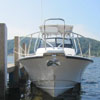
Member
Posts: 1987
Comments:
34
Joined: 04/02/05
|
Just like a car's front wheels you want the outboards to toe - in. So if you are looking off the stern off your boat the back of the motors should be closer together than the front.
When you are running you should see the prop washes coming together behind the boat.
Jeff attached the following image:
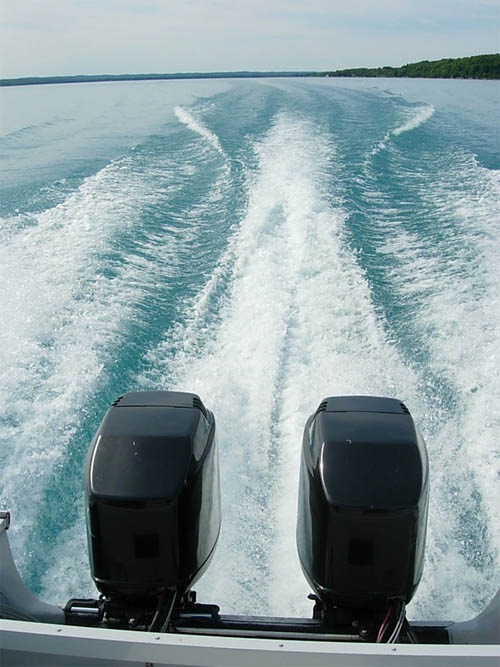
[84.93Kb]
Edited by Jeff on 01/14/09 - 12:44 PM |
| |
|
|
| rusty geller |
Posted on 01/14/09 - 2:25 PM
|
Member
Personal Page
Posts: 13
Comments:
0
Joined: 11/04/07
|
Jeff, thank you, I'll be putting them back to toe-in this afternoon.
Cliff, yes, Western Australia has wonderful water. We moved here from Southern California 5 years ago. The water here is warmer and clearer, and the beaches better. I miss Mexican food, but at least with the satellite dish I can see the NFL playoffs, though on Monday morning. The island you mention is Rottnest, locally known as Rotto.
The Whaler is a stand-out, most boats here are aluminum plate, light but with a very hard ride. The Whaler runs circles around them. By the way, my book: "Americans' Survival Guide to Australia" has a section on boating Downunder. You can read the chapter for free on Amazon, or on my website www.yankeeshout.com.
|
| |
|
|
| Tom W Clark |
Posted on 01/14/09 - 3:27 PM
|

Member
Personal Page
Posts: 4280
Comments:
7
Joined: 09/30/05
|
Just like a car's front wheels you want the outboards to toe - in. So if you are looking off the stern off your boat the back of the motors should be closer together than the front.
Jeff - That is a complete contradiction. A toe-in condition will have the fronts of the motors closer together than the backs of the motors.
Whether you want toe-in, toe-out or parallel depends on the boat. For the classic Whalers with motors mounted directly to the transom, you want toe-in of about 1/2" - 3/4" (per Whaler). By this I mean the leading edges of the gearcases should be that much closer together that the centers of the propeller shafts.
As a practical matter, use the front edges of the gearcases as the measuring point forward, but us one side or the other of the propeller hubs. This makes it easy to use a tape measure and will result in exactly the same on-center measurement.
Understand that the alignment of the twin outboards is meant to align each motors gearcase to the flow of water it passes through. While tend to think of the water flowing past and under the hull all moving in one direction, the reality is does not.
The hull parts the water pushing it aside and down as the hull moves forward. With a V-hulled boat, the water coming out form under the hull is being displaced with a lateral dimension so it appears (from the perspective looking backwards from the boat, over the transom) as if the water were shooting backwards at an outward angle.
By providing toe-in, the gearcases align with this water flow.
On boats with brackets it may be that the motors are so far back the water begins to "fill in" the hole the boat's hull carves. In this case you may have to provide toe-out to align the motors with the water flowing past them.
Some manufacturers set the motors parallel. Grady White is one such manufacturer. It may be that the motors on their hulls are set at a distance where the water no longer has a lateral element, or it may be that they just don't want to fool around with trying to explain to customers and dealers how to get the boats tuned just so.
I am not sure if the 1999 Conquest 23 has a notch in the hull ahead of the transom or not. This may affect the best toe angle. I would inquire of Whaler Customer support to see if they have a different specific recommendation for this hull.
|
| |
|
|
| Jeff |
Posted on 01/14/09 - 5:03 PM
|

Member
Posts: 1987
Comments:
34
Joined: 04/02/05
|
Tom,
What I said was to realize toe in on a boat you must face the motors from the stern of the boat and look off the transom. In this view the backs of the motors closer together.
Here is the way I have always known toe in. If the centerline of the front wheels or motors (mounted at the stern of the boat) converge to the vehicle's or boat's center line outside of that vehicle it is considered toe-in. "Toe out" on the front wheels of a car induce oversteer or a drift / sliding of the car in a turn. Toe out typically only used for skills drivers. In all of my years of years I am still yet set see anyone use a toe out set up for increased cornering and tracking. So if you set up for toe out on a boat this set up will make the hull track all over and not in a straight line.
Follow the link down for a description.
http://www.tirerack.com/tires/tiretec...hid=4&
So, using the graphic from tire rack here is how I know toe in as it relates to boats (see below). Both propellers trust directed toward the centerline of the boat. To get this the front of the motor and gear cases would have the center lines going away from each other this would put the back (stern side) of the motors closer together.
Is this wrong or just semantics?
Jeff attached the following image:
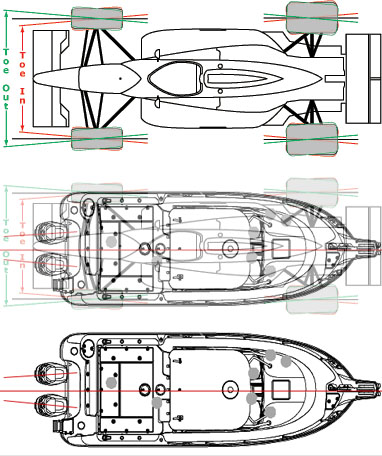
[86.66Kb]
Edited by Jeff on 01/14/09 - 5:08 PM |
| |
|
|
| Tom W Clark |
Posted on 01/14/09 - 5:25 PM
|

Member
Personal Page
Posts: 4280
Comments:
7
Joined: 09/30/05
|
Jeff,
You are mixing two things together here:
1 - What is the meaning of "toe-in".
2 - Which way should the motors be angled.
Let's go back to #1, which seems to still be nothing but confusing. So confusing, I think we should not use the term "toe" at all in terms of outboards. We had yet another long and somewhat painful discussion of the meaning of "toe-in" not long ago.
If you want to introduce the car alignment analogy, fine. Toe-in on a car means the front of the wheels are closer together than the rear of the wheels. like this:
[img]http://www.familycar.com/Classroom/Images/Align_Toein.gif[/img]
Likewise, toe-in on twin outboards means the fronts of the gearcases are closer together than the rear of the propeller shafts. What you are describing is just the opposite.
Now, as to #2, no, you do not necessarily want..."both propellers thrust directed toward the centerline of the boat."
You want the motors aligned with the flow of water around them. In most cases, this means the propellers thrust slightly away from the centerline of the boat.
Edited by Tom W Clark on 01/14/09 - 5:28 PM |
| |
|
|
| Tom W Clark |
Posted on 01/14/09 - 5:58 PM
|

Member
Personal Page
Posts: 4280
Comments:
7
Joined: 09/30/05
|
Jeff,
In your graphic, you have the car and the boat travelling opposite directions!
Flip the boat around and you will see the boat is shown with a toe-out condition.
|
| |
|
|
| Jeff |
Posted on 01/14/09 - 7:34 PM
|

Member
Posts: 1987
Comments:
34
Joined: 04/02/05
|
Tom,
That is why I noted in my description that for a boat you would need to look off the stern to see my "toe-in" definition.
None the less I take/took toe-in as the prop wash is directed toward the center line of the boat as it leaves the lower units.
I found an image of the 22 Guardian where you can see we have it set up with the prop wash directed toward the center line (my definition of toe in). We did not set the boat up this way however, both my father and left it as is because when running our twin inboards in the past they were specifically noted in the manuals to have "toe in" set into the rudders. This was described as the trailing edges or backs of the rudders needed to be closer together than the leading edges.
Just as your image shows only were it is labeled front that should be labeled stern if it was a boat. Pointing the prop wash away from the center line seems against what I have learned in the past with both cars and boats.
Trust me, I am not saying you are wrong by any means. However after making a quick cardboard model, your setting seems like it offers much better turning thrust however, while running in a straight line it seems to me like it could cause the boat to wander.
Jeff attached the following image:
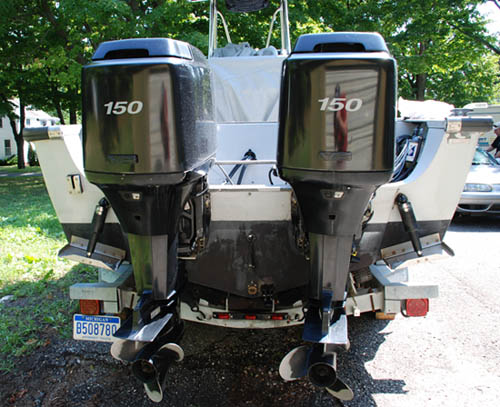
[85.8Kb]
Edited by Tom W Clark on 01/14/09 - 10:18 PM |
| |
|
|
| Tom W Clark |
Posted on 01/14/09 - 10:37 PM
|

Member
Personal Page
Posts: 4280
Comments:
7
Joined: 09/30/05
|
Jeff,
I do not mean to give you a hard time. I just know there are others reading this and getting confused so let me be clear:
It does not matter in the least whether you are looking at the motors while turned around in the boat looking backwards or standing behind the boat looking forward. The motors will either have their first closer together or further apart than the rears of the motor. It does not change when your perspective changes, nor does the way it is described change. Regardless of how you define toe-in or toe-out, your cannot switch the terms when you simply look at the motor from another direction.
V-hulled twin outboard powered boat are not cars. They steer via completely different ways. I do not think you can use a car analogy to analyze how a boat will perform.
Likewise, most inboard powered boats are not the same. The rudders are beneath the hull not just behind it. I do not think recommendations about an inboard powered boat is relevant to a twin outboard powered Boston Whaler.
Again, the goal of twin outboard alignment is to align them to the flow of water about them. That is all. This reduces drag and makes steering response more smooth.
...your setting seems like it offers much better turning thrust however, while running in a straight line it seems to me like it could cause the boat to wander.
Why on Earth would that be?
The correct alignment is not about how boats corner. (Again, we are talking about boats, not cars). Boats mostly travel in straight lines. To that end, drag is to be minimized. If the motor's gearcase is moving through the water with a slight angle to it, there will be added drag.
To determine the correct toe angle for any particular boat, one good test is to run the boat and disconnect the tie bar so the motors are free to align themselves with the water flow. The tie bar can be adjusted and reconnected while still moving and the motors will be perfectly adjusted.
I had heard of this technique for years but it always seemed really unsafe as though the one motor that was completely disconnected from the steering system would suddenly torque to one side.
Having operated my own boat with one disconnected motor this summer, I can attest the loose motor follows along just fine once on plane.
Edited by Tom W Clark on 01/14/09 - 10:41 PM |
| |
|
|
| Jeff |
Posted on 01/15/09 - 9:56 AM
|

Member
Posts: 1987
Comments:
34
Joined: 04/02/05
|
After thinking about it Tom, my comment of "your setting seems like it offers much better turning thrust" would be overcome because of the Ackermann principle. So no matter whether the motors are tow in or toe out because the steering arms connected to tie bar is the actual pivot point the inside motor in the turn will always end up with a greater turn angle.
Anyway the idea of running the motors disconnected sounds crazy but actually seems like it makes the most sense.
I do think you can use a car scenario to describe how a boat works. I can explain my reason buts it is going to take some time to write up.
|
| |
|
|
| Tom W Clark |
Posted on 01/15/09 - 10:11 AM
|

Member
Personal Page
Posts: 4280
Comments:
7
Joined: 09/30/05
|
So no matter whether the motors are tow in or toe out because the steering arms connected to tie bar is the actual pivot point the inside motor in the turn will always end up with a greater turn angle.
No, not necessarily. We are talking about boats, not cars. Let's stop trying to use car analogies.
Cars roll over a solid surface. Boats move through and over a liquid.
Cars have their steering input at the front of the vehicle. Boats have their steering input at the rear of the vehicle.
Cars will roll away for the direction of a turn. Boats (outboard powered Whalers on plane) will lean into the direction of the turn.
These are just a few of the profound differences in how they perform.
You cannot imagine the water as a solid. The hull moving through and across it is also displacing it and changing its direction. All the outboard motor knows is its gearcase flowing though the water directly around it which may be moving in a slightly different direction and speed than elsewhere under the hull or around the other motor.
|
| |
|
|
| Jeff |
Posted on 01/15/09 - 10:57 AM
|

Member
Posts: 1987
Comments:
34
Joined: 04/02/05
|
I have a model built to show what I am thinking. I will photograph it tonight. Right or wrong I hope it gives so sense of visualization to what I am thinking and I hope in the end Tom we can still be friends =).
Edited by Jeff on 01/15/09 - 11:09 AM |
| |
|
|
| CES |
Posted on 01/15/09 - 11:52 AM
|

Member
Personal Page
Photo Albums
Project Albums
Posts: 2681
Comments:
7
Joined: 04/27/07
|
Rusty,
Yes! That's the island I dove when I was there.......sure is a nice place. Perth reminds me in so many ways like San Diego. The mild weather is similiar to San Diego however, like you mentioned, the water is much nicer. Also, Perth is not NEARLY as crowded or obnoxious as San Diego is. You're one lucky fella.
Cliff
1966 13' Sport with a 1993 40hp Yamaha 2 Smoker |
| |
|
|
| Jeff |
Posted on 01/15/09 - 8:37 PM
|

Member
Posts: 1987
Comments:
34
Joined: 04/02/05
|
OK FORGETTING EVERYTHING MENTIONED ABOVE Here are the two settings... The images depicts a top view of the stern of a boat. Each block is a motor and is turned via a steering arm using a simulated tie bar. Arrows show direction of the water force as it leaves props and the lower units while the boat moves forward.
Example A
Jeff attached the following image:
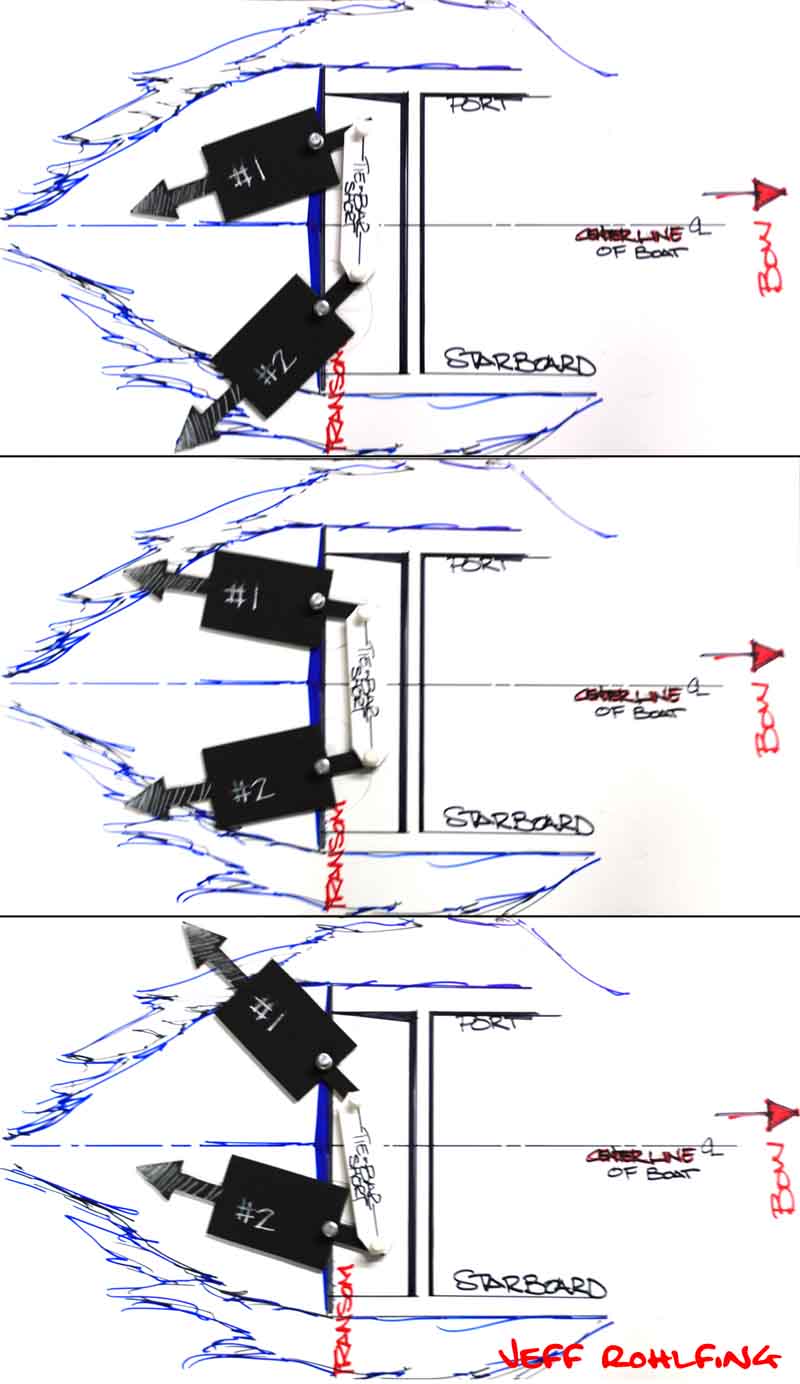
[88.98Kb]
Edited by Jeff on 01/15/09 - 9:32 PM |
| |
|
|
| Jeff |
Posted on 01/15/09 - 8:38 PM
|

Member
Posts: 1987
Comments:
34
Joined: 04/02/05
|
Example B
Jeff attached the following image:
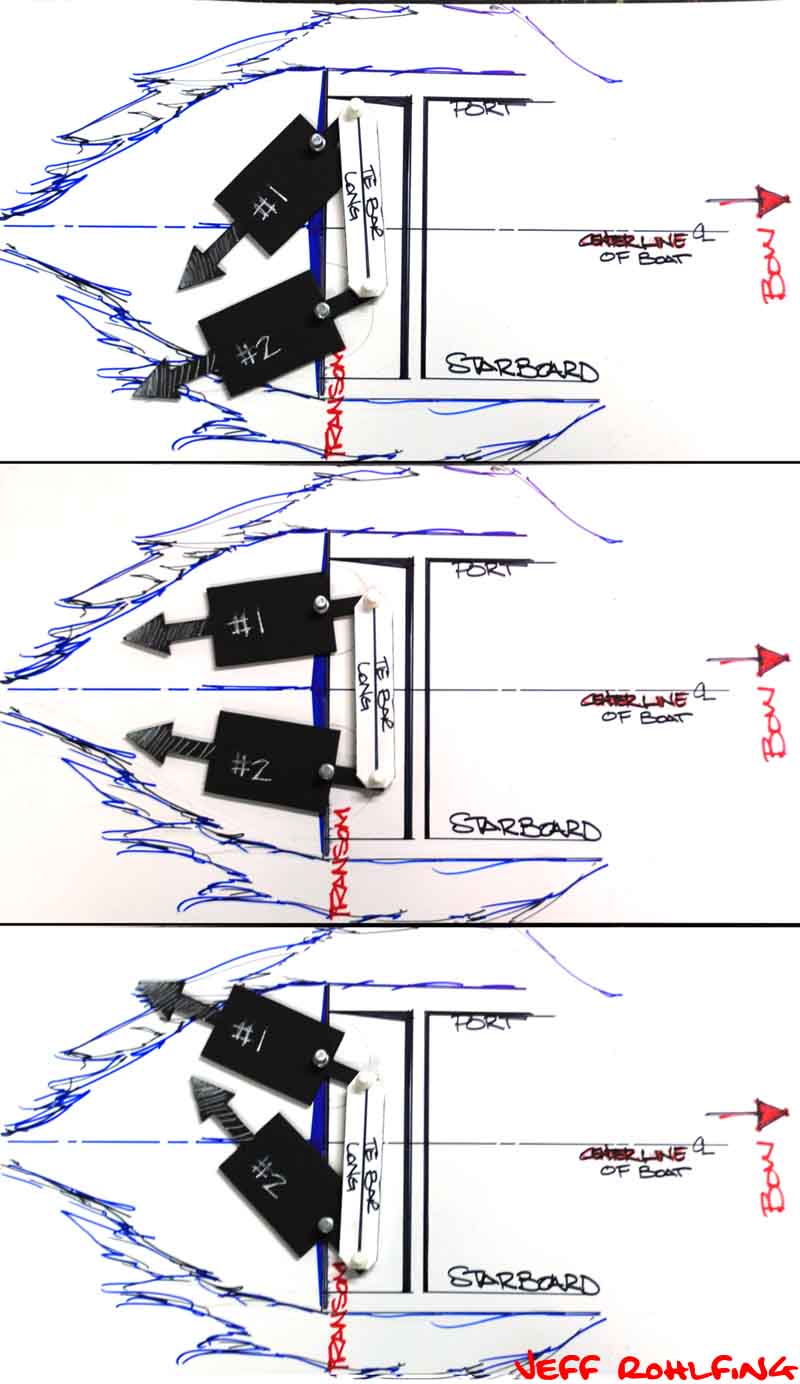
[95.42Kb]
|
| |
|
|
| todd12 |
Posted on 01/15/09 - 9:05 PM
|
Member
Personal Page
Posts: 220
Comments:
0
Joined: 07/27/06
|
Jeff or Tom
Question ?
What type of performance difference would one expect to see if the twin outboards were mounted straight to the transom VS the toe in/toe out configuration ?
Are there special shims that accomplish the toe in or toe out setup ?
Thanks,
Todd
Edited by todd12 on 01/16/09 - 5:02 AM
Todd |
| |
|



